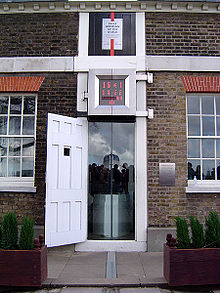- Meridian (geography)
-
This article is about the geographical concept. For other uses, see meridian (disambiguation).
A meridian (or line of longitude) is an imaginary line on the Earth's surface from the North Pole to the South Pole that connects all locations along it with a given longitude. The position of a point along the meridian is given by its latitude. Each meridian is perpendicular to all circles of latitude. Each is also the same size, being half of a great circle on the Earth's surface and therefore measuring 20,003.93 km (12,429.9 miles).
The meridian through Greenwich, England, also called the Prime Meridian was set at zero degrees of longitude, with other meridians being defined by the angle at the center of the earth between where it and the prime meridian cross the equator. As there are 360 degrees in a circle, the meridian on the opposite side of the earth from Greenwich, forming the other half of a circle with the one through Greenwich, is 180° longitude, and the others lie between 0° and 180° of West longitude in the Western Hemisphere (West of Greenwich) and between 0° and 180° of East longitude in the Eastern Hemisphere (East of Greenwich). Most maps show the lines of longitude.
The position of the meridian has changed a few times throughout history, mainly due to the transit observatory being built next door to the previous one (to maintain the service to shipping). Such changes have had no significant effect as historically, the accuracy of the determination of longitude was much larger than the change in position. The adoption of WGS84 as the positioning system, has moved the meridian approximately 200 metres east of its last position (measured at Greenwich). The position of the current meridian is not identified at all in Greenwich but may easily be located using a GPS receiver.
The term "meridian" comes from the Latin meridies, meaning "midday"; the sun crosses a given meridian midway between the times of sunrise and sunset on that meridian. The same Latin stem gives rise to the terms a.m. (ante meridiem) and p.m. (post meridiem) used to disambiguate hours of the day when using the 12-hour clock.
The magnetic meridian is an equivalent imaginary line connecting the magnetic south and north poles and can be taken as the magnetic force lines along the surface of the earth.[1] That is, a compass needle will be parallel to the magnetic meridian. The angle between the magnetic and the true meridian is the magnetic declination, which is relevant for navigating with a compass.[2]
See also
- Prime Meridian (includes other reference meridians)
- Meridian (astronomy)
- Parallels
- Meridian lines used with a gnomon to measure solar elevation and time of year
- Meridian arc
For meridians used as references in surveying:
- Public Land Survey System, United States
- Dominion Land Survey, Canada
References
- ^ http://www.met.gov.pk/Subpage4/geomagnotes.html
- ^ http://brunelleschi.imss.fi.it/museum/esim.asp?c=100234
External links
- The Principal Meridian Project (US)
- [1] Note: This is a large file, approximately 46MB. Searchable PDF prepared by the author, C. A. White.
- Resources page of the U.S. Department of the Interior, Bureau of Land Management
Circles of latitude / Meridians  145°145°65°75°Categories:
145°145°65°75°Categories:- Surveying
- Lines of longitude
Wikimedia Foundation. 2010.

